Antifa-la-la-la-la.
Sunday, May 31st, 2020
I opened the Sunday morning newsscreens with trepidation, because when I went to bed it seemed as if cities were again ablaze and people were being set upon by the cops in a mirror of the brutality that is the focus, the very reason for the protests.
And now well into the next day, I fear what’s been happening may or may not play out on repeat this evening after curfew in Minneapolis, New York, LA, and…Atlanta…and other cities nationwide. (Columbus Ohio? Yikes.)
The recipe varies in each city, but seems to include: protesters who want systemic change in how policing is done in America, as exemplified by the awful death of George Floyd, what was it, a week ago? Stir in overwhelmed local police forces that have been augmented by state police and in more places, the National Guard. Let the curfew hour pass. If there’s anyone on the streets left (including journalists and medics), start tossing tear gas grenades and herd people out of the protest locale. Then, the secret sauce: these other folks who come from…where, exactly? They’re not protesting. They’re lighting up cars and breaking windows. Finally, fire up the very brutality that protesters are trying to change, and, well, hurt people, more or less with impunity.
Then serve up tepid apologies from the Governor the next morning. “Inadvertent” incidents where people were hurt by cops with rubber bullets, pepper balls, or gas canisters. Except: they weren’t. We have a growing digital record of cops silently taking aim on people and pulling the trigger.
It reminds me of the behavior on the first person shooter games I see my nephews play. I’m not at all a gamer, but I see the poorly-rendered tough-guy grimaces on the characters, and the blank-faced kids holding the controllers remind me of the nerdy young cops behind the masks and body armor. They’ve somehow turned the people they should be serving and protecting into an abstract ‘enemy’, an enemy that they have reduced to somehow less than human.
And then to once again focus national energy on exactly not the problem, the President tweets that something called ‘ANTIFA” (his caps) will be placed on, well, I’m not sure, some sort of list of domestic terrorism. Antifa. Anti-fascist. Those who are opposed to fascism. In recent history, it’s not even an actual organization, more an (extremely) ad hoc collection of people who assemble to object and protest when nazis and fascists march in public, spewing hate.
I look at that as just another Trump attempt at misdirection. I am trying to visualize how we change the system of law enforcement moving forward. Sure seems like it involves dismantling the whole thing and tossing out bad actors, reducing bloated budgets, removing the surplus military component that has led to tiny Georgia cities driving huge armored personnel carriers. And then training. Something like empathy training, but on steroids.
And then getting people to trust Police 2.0 (or 20.0) will be an even bigger leadership challenge. Trust through the screwups and the flaws and the rough edges of a new system.
Seems like a task way bigger than launching humans into orbit.
Saturday night, curfew.
Saturday, May 30th, 2020
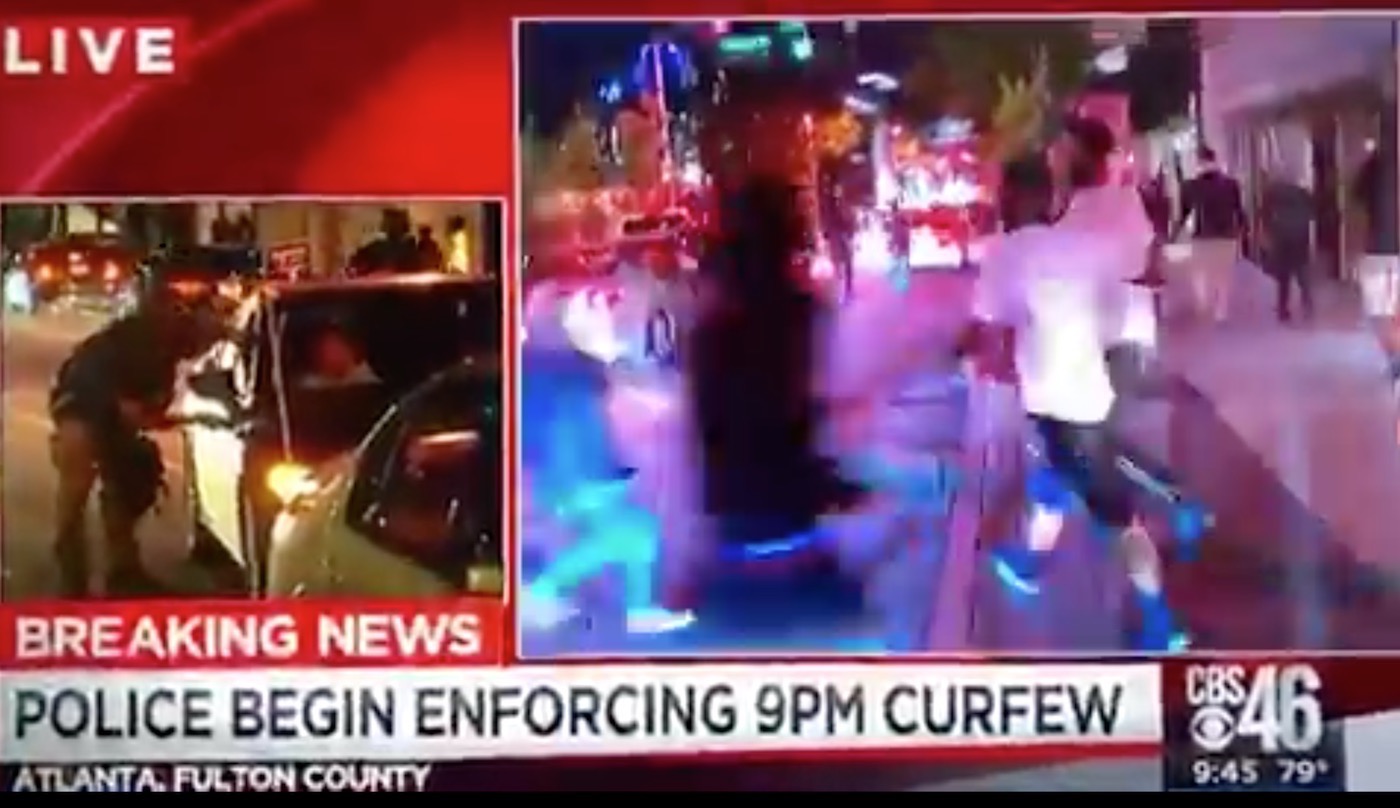
Just a couple of notes from watching the coverage of nationwide protests of the murder of George Floyd by Minneapolis police, and adjacent violence, looting, and property destruction that may have nothing at all to do with the protest itself.
- There continues to be discussion of ‘outsiders’ actually causing the glass breaking and the vehicle torching. Atlanta’s police chief said right out that they think they see two different factions—the protesters and these ‘others.’ Who are they? Anarchists, says the chief.
Former FBI counterintelligence director Frank Figliuzzi said on MSNBC:
“We’re seeing evidence in the protests that right-wing dangerous militia groups are there. We’ve seen flags and symbols that come from both Boogaloo Bois and dangerous militia groups,” he warned. “On the far-left, we’re seeing some evidence developing of global anarchists showing up.”
“Boogaloo Bois” on the right, “Global Anarchists” on the left. Still not much for a journalist to hang his or her hat on.
- It sure looks like state police and national guard troops are following plans that say: show up in overwhelming numbers, disperse protestors, violent or not, if they continue to protest past curfew. Use force to achieve empty streets.
- I feel as if I’m watching the children of Ferguson, their agonies spread nationwide.
Friday night, aflame.
Friday, May 29th, 2020
Tonight Atlanta joined other US cities in tipping over from mostly peaceful protest to rage, and late Friday evening, it’s too early to reliably say why that shift happened.
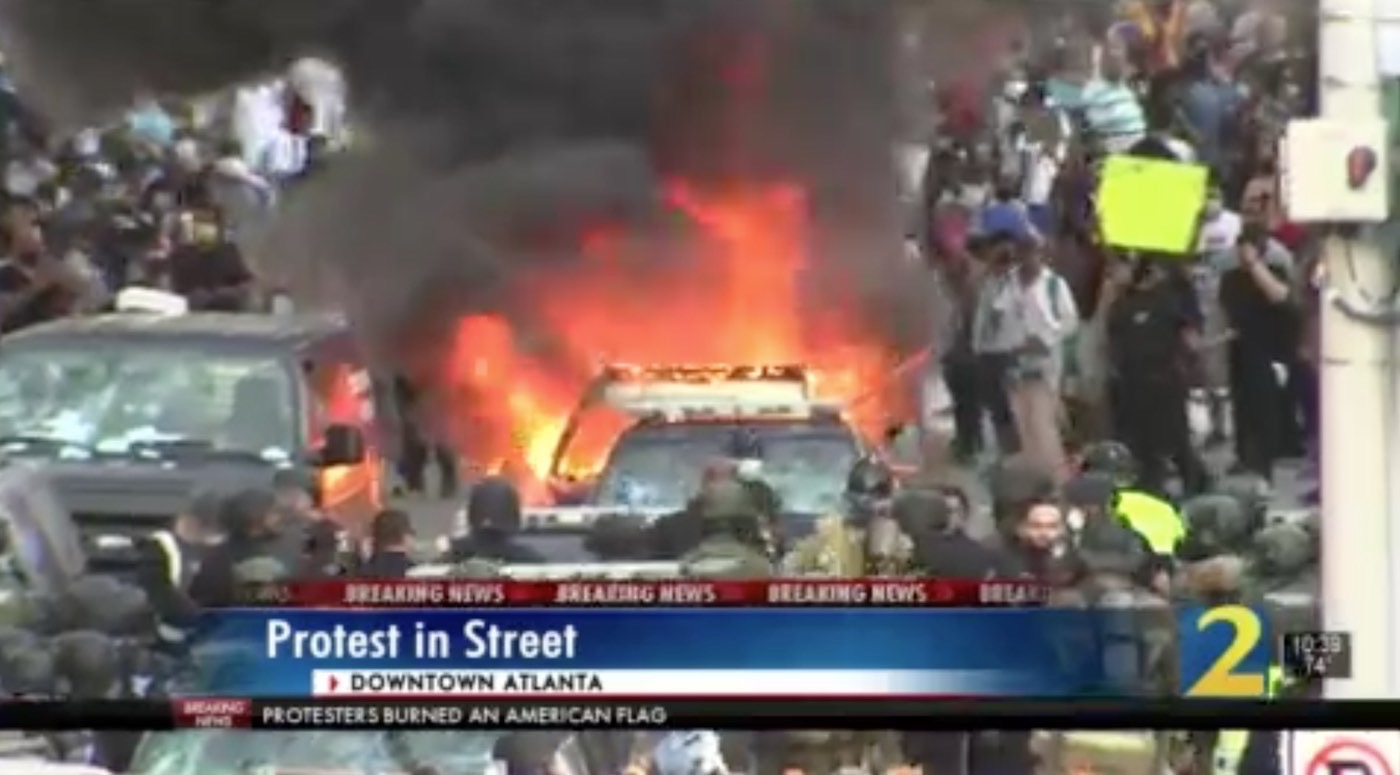
I can tell you that the protests earlier in the day were peaceful, marching from Centennial Olympic Park to the State Capitol and back. They were angry, passionate, but not randomly violent.
And then, after sundown, cars were set ablaze and windows were shattered at CNN Center and down Marietta Street.
Sometime after 9 pm, our mayor, Keisha Lance Bottoms made a plea to Atlantans to stop the violence and simply “go home.” She invoked the entire history of peaceful civil rights protests, the legacy of Dr. King (of course) and spoke as a mother of 4, the oldest of whom is (I think she said) 18. She wanted him home and safe. She wanted all young black men home and safe.
It was a very powerful (surprisingly intense and passionate) message to my ears, but I’m not among the people she’s trying to reach. I’m not sure they’re listening. And I’m not sure they think that their government listens either.
And I know that the virus that still overlays close, sweaty public gatherings everywhere cares not about the systemic problems of American justice.
Tin soldiers.
Thursday, May 28th, 2020
I started this month with a remembrance of the National Guard shooting college students at Kent State and Jackson State in May of 1970, a half-century ago.

We sat tonight in the waning days of May and watched protest and anger in Minneapolis continue to boil over in the wake of the violent murder of George Floyd by Minneapolis police. The familiar tools of crowd control from the 1970s—tear gas—were accompanied by the more modern ‘flash bangs‘ that, although not lethal, can injure those nearby.
This series of protests, some nonviolent and organized, some a painful overlay of chaos and property destruction, played out on live cable news since Tuesday night.
We also saw vivid reporting from the scene that emerged from a single handheld iPhone (a Minnesota Public Radio reporter talking with Rachel Maddow, a very effective interview) as well as from MSNBC’s Ali Velshi, there with a photographer and a producer, and a gas mask at the ready.
Amidst all of this, Maddow talked with the mayor of Minneapolis and the Attorney General of Minnesota.
The interviews served to put this one incident in a context of a policing system that hasn’t worked for black victims of white cops almost anywhere in the past, and, the protestors fear, the system’s failure will repeat itself as the Hennepin county attorney, Mike Freeman, asks for “patience and calm” in the face of a furor that wants the officers involved charged right now. He wants slow. They want swift justice.
And to add to the complexity, Freeman’s immediate predecessor was US Senator Amy Klobuchar. The Star-Tribune reports:
Derek Chauvin, the officer involved in Floyd’s death, was involved in the death of another citizen while Klobuchar was prosecutor. Chauvin was one of six officers who fired on and killed Wayne Reyes in 2006 after Reyes reportedly aimed a shotgun at police after stabbing his friend and girlfriend. While the death happened during Klobuchar’s tenure at the helm of the Hennepin County Attorney’s Office, the case did not go to a grand jury until after she left the office and became a senator.
That doesn’t add up to blaming the senator for Floyd’s killing (although some on Twitter are trying to do exactly that), but it does show that simply being a “tough law-and-order prosecutor” doesn’t mean that justice is being done in these cases across race and class.
There are a lot of systemic threads to unravel until Minneapolis can have a quiet night’s sleep. The work on a messed up system that will allow African Americans to sleep, live, and work peacefully as citizens in every sense will take a while, but it feels like, amidst a pandemic and a crazy executive branch, foundational change may be happening.
Flowers and a river.
Wednesday, May 27th, 2020

I can still do a lot of blogging/writing things with my iPad Pro from 2018 or even with my iPhone, but it’s nice occasionally to have all the MacOS tools available, which usually includes access to photos and easy access to content in multiple browser windows. So when Sammy wasn’t deep into research, I grabbed our MacBook Pro.
I noticed that my past few days’ essays have been image-free, and this photo today, an image of lovely flowers next to a quietly flowing river, well, that’s a few days old, and has nothing to do with what’s in my head, but… it’s flowers and a river, so please! Enjoy!
I was kinda prepared to talk about the launch of humans into space from Florida, but that’s been postponed until the weekend at the earliest—stormy weather at the launch site. The project stirs up the old excitement about Americans in space, delivered by capitalism and ambition, but the political statements of SpaceX owner Elon Musk leave me cold, to say the least.
I was even kinda prepared to try and talk about the brutal police violence that killed an African American man in Minneapolis, and the inequities of race that enabled a scofflaw white dogwalker in Central Park to decide that the best way to deal with being asked to reattach the leash to her dog (it’s right there on the sign, lady) was to call 911 and claim she was being threatened by this black man…this…birdwatcher. Augggh.
And I listened to a podcast today where CNN’s Christiane Amanpour was interviewed about the 40th anniversary of CNN and had a few thoughts I thought I could talk about, but that can wait until Monday, the actual date.
Until then, I’m going to meditate on this image, and maybe go out and accumulate some more interesting ones.
Blooms, stars, microseconds.
Tuesday, May 26th, 2020
I mentioned developing blooms on apple trees as a measurement of time’s passage, which, when I live in a world surrounded with very precise digital time measurement, seems like a very very imprecise choice.
And when you’re counting on the cycles of things biological, you have to factor in all the stuff I really don’t understand, like rainfall amounts and sunshine and well, truth be told I can’t tell you that all the apple trees in an orchard will be fully a-bloom on precisely May 29th, nor can I assert the lupine will display in lovely wisteria-like purple on June 7th. Beats me. Some years it’s one way, other years it’s another.
I could, of course, go out at night and look at a subset of nature that is less affected by the small stuff like moisture and light. I’m talking about the stars. And heck, I have right here on my phone this great planetarium-y app that uses my precise orientation and location to tell me all I need to know about the alignment of stars, planets, comets, International Space Stations.
Of course that is the cheatingest form of cheating to do that, because it’s using satellites and trigonometry and the secret sauce of GPS to figure out exactly what field I’m out standing in.
So I suppose I need to be honest with myself. Self: it’s the end of May. You’ve got data. You’ve got resources. You don’t have any novel coronavirii (I think.) And when I hit ‘publish’ on this post, the exact moment in time will be entered, logged, memorialized in a fancy SQL database along with these words. It’s all fine.
My finger’s headed toward the button.
Echo chamber.
Monday, May 25th, 2020
I think the reason I occasionally dive into the depths of the Twitter and “offer” my thoughts to those who, for example, think “sports should be back,” period, full stop, is not that I think I can persuasively open their eyes to the light of day…no, no.
I think there is a useful non-futile effort in making sure that their world, for a brief moment, extends beyond the echo chamber of their golf buddies and fellow Rush Limbaugh listeners. Even if they’re not persuaded, they are just a tiny bit aware that their opinion is not universal.
Look! Behold! A guy who looks like them is saying that you can’t just read up a bit and “common sense” this pandemic any more than your gut can land a 787 or your instincts can calculate the parabola of a missile. Math exists (among many other reasons) to help us do the right thing even when that trajectory, that timeline, that curve is not intuitive.
They often slap back with something like “well, you can hide in your house if you want, but I’m out here with my friends having a beer.”
And I want to reply that I’m not hiding at all, but I am following the guidelines, but they’d rather chant “USA! USA!” And tune that out.
I honestly believe (and I’m quoting my own tweets here) that schools used to teach us—explicitly— how to be and that you should be responsible members of society, which by definition means learning a certain empathy and understanding about how your actions affect those down your street, in your county, in your state.
Somewhere in the past two or three decades, maybe at the end of the Cold War, that particular curricular McNugget got dropped, only to be replaced by some sort of “freedom means whatever the hell you want to do” idea that is more selfish 14-year-old than it is societal leadership.
“I’m willing to risk it” carries with it no sense that in a real, connected world you are not deciding for yourself.
“It’s my choice” only works in a vacuum.
Maybe, months from now, we’ll be teaching societal responsibility anew, as a lesson for the next generations.
Judgement.
Sunday, May 24th, 2020
I remember reading Bob Woodward’s 1979 book about the backstage doings at the United States Supreme Court and coming away sufficiently sanguine about their willingness to do the judicial work: to examine a case brought before them on its merits and in the light of precedent, and to listen to and be persuaded (intellectually, not ideologically) about their legal argument.
I came away thinking that all the way down through the Federal Court system, this sort of rigor prevailed, and that the appeals process was there for when a lower judge made a mistake, literally a legal faux pas, and the misstep needed thus to be corrected.
They were there to interpret and examine the laws passed by the legislative branch, and that’s all.
This was a long time ago—heck, the title of the book was “The Brethren,” so you know that it preceded Justices Ginsburg, Kagan, Sotomayor, and O’Connor—but I look now at the seemingly impenetrable political overlay welded into our nation’s judicial system by the relentless work of Senate Majority Leader Mitch McConnell and the Trump administration and I really miss the idea that the courts once built precedent on laws, fairness and it was meant to last, and not merely be overturned by underprepared lower court judges nonetheless appointed to lifetime positions and carrying their political chips very visibly on their robed shoulders.
I was just thinking about this because the work of the ACLU and others won one this evening. In Florida, where voters passed a constitutional amendment restoring voting rights to thousands of ex-felons, US District Court Judge Hinkle ruled that a follow-up law passed by the GOP-led Florida Legislature and signed by Governor DeSantis was unconstitutional because “the State of Florida has adopted a system under which nearly a million otherwise-eligible citizens can vote only if they pay an amount of money. … Many do not know, and some may not be able to find out, how much they must pay.” (It’s really a mess.)
But yeah, the Governor could still appeal. And appellate courts could be run by judges who treat a matter of law like a matter of my team versus theirs.
In a just world, I’d be sanguine about the process. Nowadays, I just hold my breath.
Not memorial.
Saturday, May 23rd, 2020
I had to take a look at the calendar and recalibrate for a moment. No, Memorial Day is not until Monday, and that, in our family, kicks off another 20 days or so of birthdays. This is just basically Saturday. A day of “hey, we’re open! Freedom!” …for many. (Some will be celebrating said freedoms more sensibly and conservatively than others.)
But the calendar! The way we measure time in this thing versus before. The missed gatherings with birthday cake. Even though the precise date and time hangs out at the top of every device I use (I can see it there right now) I need to squint and look at it again, and maybe one more time to be sure. Are we paid up on our property tax yet? Oh yeah, that was in March. How about our car tags (nah, trick question: the Georgia tag offices are closed for pandemic and won’t even process mail-submitted renewals until they open back up. We’ve been given a moratorium.)
Our devices are great at this whole pile of notifications and remindering. I’m just looking at them a slightly different way. Of course maybe I should power it all down and just go out and measure time by watching the apple trees slowly come into bloom.
If only.
Friday, May 22nd, 2020
I’m trying to avoid going too far down the “if only” path because, well, that way leads to frustration, a sort of circular bitterness unsuited to end-of-evening journaling.
One of my big lessons out of the pandemic and the US response to it (and, honestly, the response from many other places around the globe):
People want to feel independent. Held up from a certain angle, you’d say “yeah, selfish,” and yep, those who describe their choices of where they’ll go and whether they’ll wear a mask and how close they’ll get to people as “a choice I get to make for myself” while adding “that’s freedom,” well, it’s hard to take them back to 4th grade and say “let’s look that this freedom concept in the context of all your neighbors and coworkers.”
Here’s another one. A lot of people skim the information and then (they say) “trust their gut,” which is, of course, idiotic. This is a global crisis that involves an invisible thing that can spread from person to person without necessarily developing symptoms. The logarithmic math of the spread in our very connected modern world is hard for a bluster-filled leader used to skimming and making it up as he goes along to understand, let alone accept. If you define the problem as “damage to the economy” before you define it as “damage to humans who will lose jobs, be forced to work in dangerous conditions, spread it faster than you can measure,” well, that maybe in one teeny way explains why the President failed to lead for such a long time.
Reading about Columbia University modeling which suggests that starting what inevitably gets described as “the lockdown” 7 or 14 days earlier would have saved up to 36,000 American lives just triggers that “if only” instinct…I wanna toss up my hands and, well, having parsed all of that, let’s move forward and do the things we can do tomorrow and the next day.
Like being safe. And voting.
Data out on the land.
Thursday, May 21st, 2020
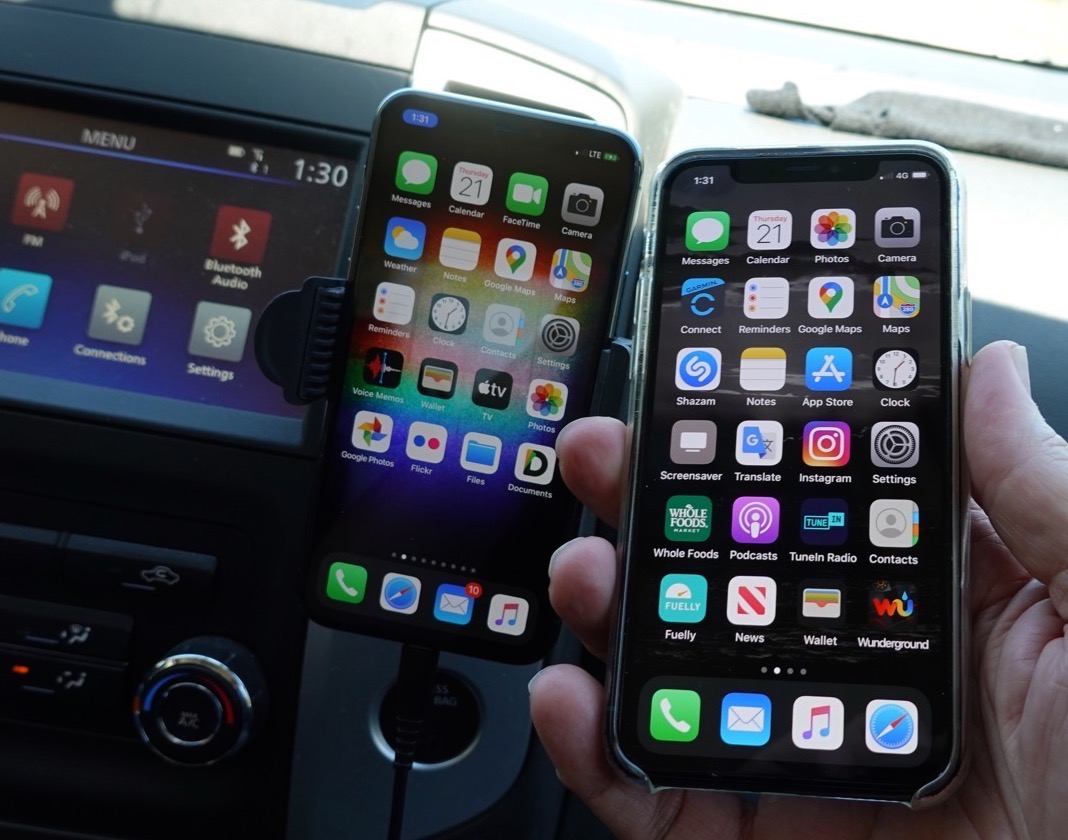
People who live in rural areas are discovering in our new be-at-home, family-be-with-you-at-home reality that the choice of which cell provider you have can make a difference in the quality of data. Quality as in “is it fast and abundant?”
And beyond the big three or so, if you have a cell provider that is reselling service from one of the U.S. big folks (AT&T, Verizon, T-Mobile) they may have great deals on data, but in the tiny type it may say that during times of high usage on a particular cell tower, you may be ‘deprioritized,’ which is a polite sounding way of saying your data speeds, specifically, your download speeds, will be throttled down to those of a bygone era. You will be put in line behind those with more premium plans from the big three themselves, and thus you will get data crumbs, not all-you-can-eat richness.
For a variety of reasons, Sammy and I have nearly identical iPhones with two different providers, AT&T (prepaid) and a service named Visible, which is fully owned by Verizon. The latter service is strong at our little cottage in the Upper Peninsula, until too many users cram onto the solitary cell tower we all share, and wammo, download speeds plummet. The former has a weaker signal overall where we want to use it, but it’s, as far as we know, never deprioritized.
If you live in a place like this and want to be sure that first of all you can even ‘see’ (pick up the signal of) at least one of a certain company’s cell tower, what do you do? (Say, for example, you’re a new phone owner and want to pick a carrier.) Well, the companies will tell you they have these great coverage maps. These maps are of course, wildly optimistic and wildly vague and they don’t show you where the towers precisely are, and even if you spot a tower, it’s probably owned by a tower-owning company who is leasing space on it to one of the big three, and that information (which towers are hosting who) should in a just version of the United States, be easy to access from, say, the Federal Communications Commission, because we are talking about radio signals and transmission towers here, but…sadly, no, it’s treated as proprietary corporate information. Just look at these fine colorful vague maps again!
So sometimes when we’re in an area we can at least do a reliable comparison between our two phones, side by side, as we drive through rural places. Some places: “ah, strong Verizon LTE.” Others: “I think the AT&T’s stronger, two bars…wait, dropping to one.”
Some of the places we thought we knew well are definitely, post-Coronavirus, suffering the effects of too many people at home trying to eke what they can out of overburdened towers.
Which makes me want to run the FCC, take it over, and mandate more reasonably-priced, LTE signal for more rural areas, and an end to deprioritization. Connect as many as you can, but don’t make some take a back seat to others. Things getting clogged? Incentivize building new towers or adding new transmitters on existing towers, fast. Let’s have clear data on how many people can use tower X serving community Y at the same time.
In these times in rural America, it’s not just for fun and games. It’s a lifeline.
Specifically…where?
Wednesday, May 20th, 2020
I realize a tweet is not a news report. I realize it is not an abstract, or a lead paragraph in a story.
But it is also not a container of clickbait. If you’re a news organization and you’re sending out tweets linked to stories, then you have a responsibility to tell enough of the story so the reader’s brain does not explode with “omg, where was this?”
Yesterday, ABC News tweeted:
DAM BURST: Residents who live along two lakes and a river in Michigan urged to evacuate after dam fails following days of heavy flooding across parts of the Midwest.
Two lakes and a river…in Michigan, a state with thousands upon thousands of lakes.
Later on the Twitter, we learned “a city was placed under an evacuation order.”
If I was the grizzled old man in the newsroom (and believe me, I’ve been working on my grizzledosity), I would walk up to the young underpaid person cranking out this handful of characters and yell “WHERE! WHO! WHAT! WHERE! WHEN!”
Specific place information should be in your tweet instead of a tease. A tweet should not be written as if Michigan is this far off abstract place that is being peered at from a great distance. People want to know. “A number were injured”—tell us that number or get as close as you can. “Opponents of the bill”—name them.
Specificity is part of the job. There are very rural places in Michigan. There are very large cities. Many of them are adjacent to “two lakes and a river.” One of them happens to be Midland, Michigan, a city I don’t know well at all except that I learned early on that the huge Dow chemical company was based there. And it’s located in central Michigan, close to where the thumb attaches to the rest of the mitten that is the mitten state.
Dangerous chemicals. A populous city that has a name. Y’know, ABC, there’s stuff to somehow get into your tweet.
It’s on the banks of the Tittabawassee River. And yeah, that is the city, the river, the chemical plant (a superfund cleanup site) and the dams involved (so far) were the Edenville and the Sanford.
Specifics!
I was happy to see this New York Times report had most of that in there, along with a lot of interesting detail. It’s very soggy in Michigan right now, and these were and are not the only dams at risk.
TripTik.
Tuesday, May 19th, 2020
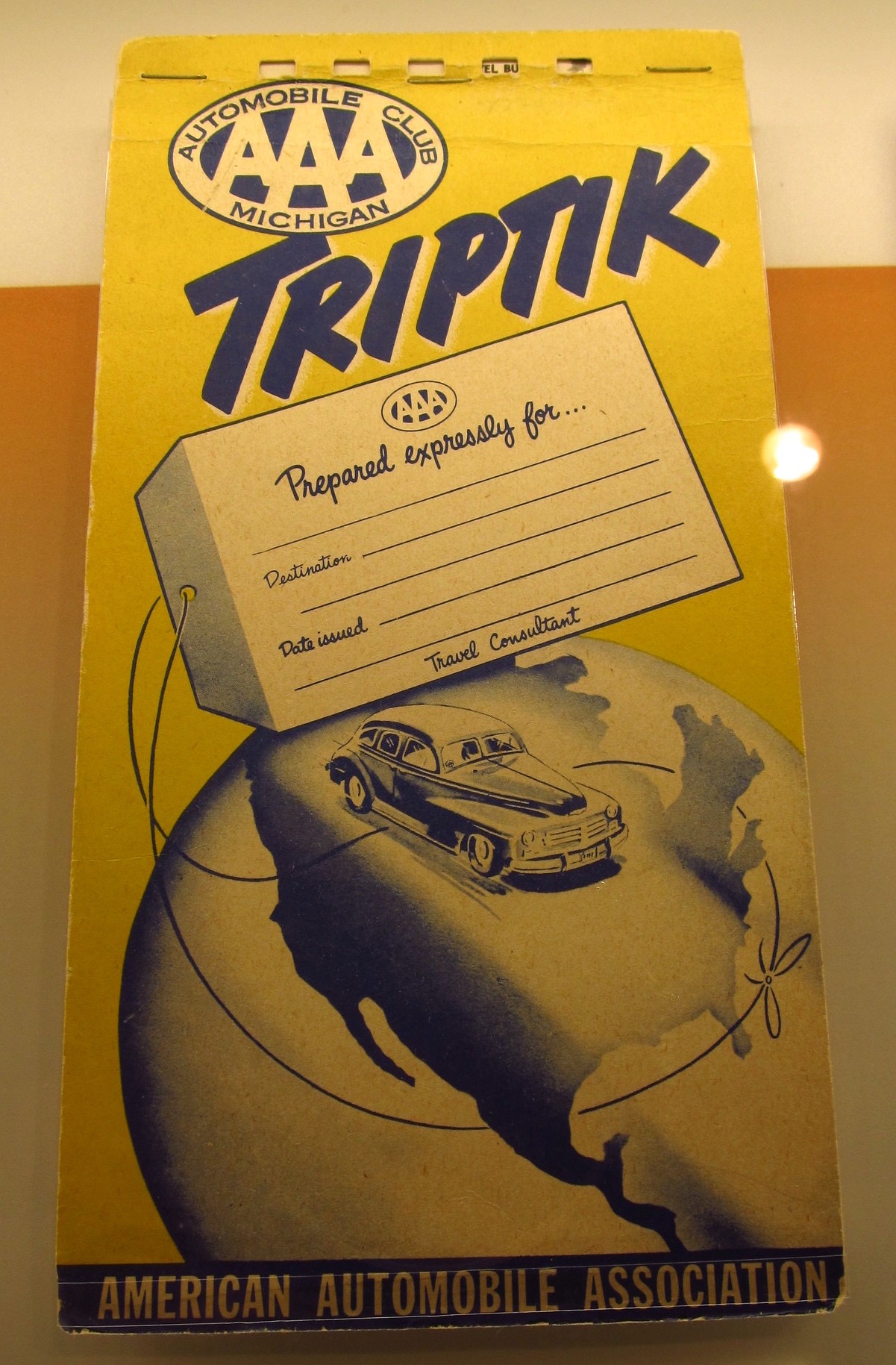
A 1951 AAA Triptik at the Henry Ford Museum, photo by ‘Jasperdo’ on Flickr.
My dad always liked maps (as do I.) When we’d get ready for a particularly complex road trip, he’d go down to AAA and get us a TripTik. I know Sammy’s dad sometimes did much the same, because two or three of them survive up at her family’s cottage in upper Michigan.
These would always be a supplement to the reliable ‘big picture’ Rand McNally Road Atlas, and they really were a different animal—a series of spiral-bound vertical sheet maps upon which our route was set out by an expert employee with an orange highlighter. (I guess now you’d say the sheets were “portrait” aspect, like uh, our phones.)
Since a lot of our travel happened in the midst of the original construction of the Interstate Highway System, the route was often a patchwork: “you’ll be on the superhighway until Cartersville, and then it’ll dump you out onto old US 41 here, and there’s some construction that’ll really slow you down, and…” My Dad always said those AAA people really knew their roads—where the construction was, where you could find a top-rated motel, the name of that breakfast place he liked in Cordele, Georgia.
We’d end up with a super-customized map that had our specific route, and it was marked up with (by 1960s standards) very fresh information.
Nowadays of course our route (if we needed it) is displayed on a bright iPhone screen and is extremely up-to-the-moment—which places are ‘temporarily closed’ because of Coronavirus and even what the gas prices are at the next exit up the road.
Almost feels like cheating.
Thumbnails.
Monday, May 18th, 2020
Last week at this time I talked about clever coding I did to deliver up big batches of Instagram pics I had posted (totalling some 3250 over the years) and tonight after all the monday night chores (garbage, dishes, financial stuff) I just kinda looked at the screen and smiled as some of them rolled by, floating on the whims of random number generators.
Mostly because I feel kind of worn out and its almost midnight and I don’t have it in me to express outrage over pandemic mismanagement or any of that.
So instead. A toxic frog. A big chicken. A painted midwestern barn. A lighthouse from my childhood that now means potato chips. A logo I designed literally on a napkin for a TV station in Cleveland. And more.
Best wishes, good night!
Reduced pressure.
Sunday, May 17th, 2020
Our Sunday was outside the usual pattern, in that instead of walking the neighborhood, my partner suited up (notice the really fancy suitable for cleaning out the stables if we had stables british boots) and we applied water pressure to the front steps, the wall out front, and quite a bit of our two vehicles.
I did a little bit and served (as TV people would say) as her grip, keeping hoses and cables connected and more or less out of the line of fire and extended far enough that we could reach the targets.
And we did all that before the heat of the day, which did indeed arrive. Atlanta is drifting into its summer weather patterns.

Later, I chatted a bit with our neighbor (20 feet or more away on her porch) while I tried to vacuum out the car a bit. All in all, everything’s in better shape.
It kinda felt like a Sunday!
Saturday’s AJC.
Saturday, May 16th, 2020
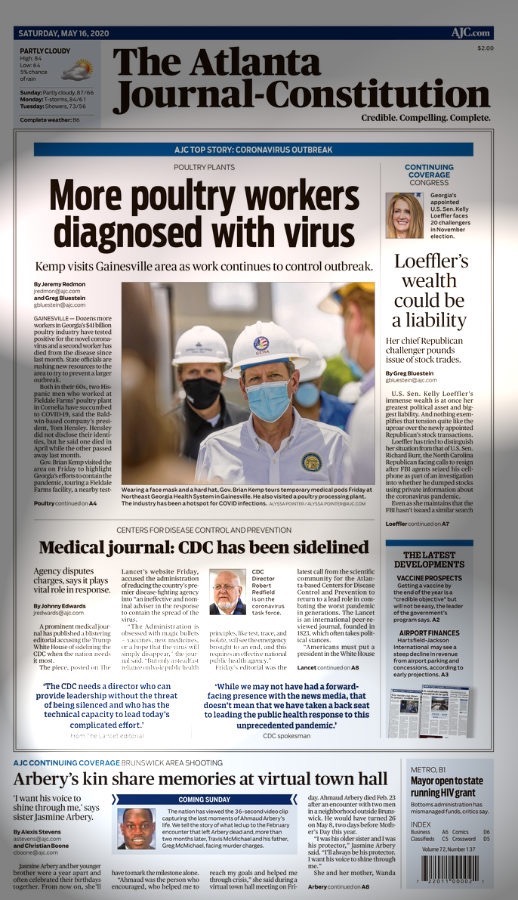
I know I’ve been on some weekends looking at front pages from a half-dozen or more newspapers across the United States, but I thought Saturday’s AJC, The Atlanta Journal-Constitution, kinda hit all the high points, at least from the perspective of, well, where I sit.
- More Poultry Workers diagnosed. This story is centered in Hall County, just under an hour northeast of the Atlanta metro, and the center of Georgia’s poultry industry. The last time I took a Greyhound, a couple of years ago, from Greenville SC back to Atlanta, we stopped in Gainesville and a lot of my fellow bus travelers got off to get to work at one of the nearby poultry plants. They were, to a person, speaking Spanish.
- Loeffler’s wealth could be a liability. Our appointed junior senator, staggeringly wealthy and married to a guy whose (Atlanta-based!?) company owns the New York Stock Exchange—he’s also super-rich—did some pretty darn suspicious trading in the early days of the pandemic. She is probably guilty and should be charged like her senate colleague Richard Barr. (In my opinion. But hey, you’re reading a blog here. There’s lots of my opinion.)
Her fellow Georgia senator David Perdue is “poorer”, relatively speaking, but also a financial miscreant, from what I’ve read. - CDC has been sidelined. Yep. And you should probably read the entire editorial on The Lancet’s website. We have this great world-respected health resource, and we’ve just kinda pulled the plug and jammed a muzzle on it.
- Arbery’s kin share memories at virtual town hall. And catch the AJC’s Saturday update, covering a large crowd, many wearing masks yet locking arms in solidarity, who marched in Brunswick to demand the resignation of the two South Georgia DAs. I couldn’t help but fear for the protestors’ health even as I saw some post-Covid precautions at the march. I also hope fervently that these protests will lead to legislative and systemic change, beyond this particular gruesome murder.
Well done, AJC.













